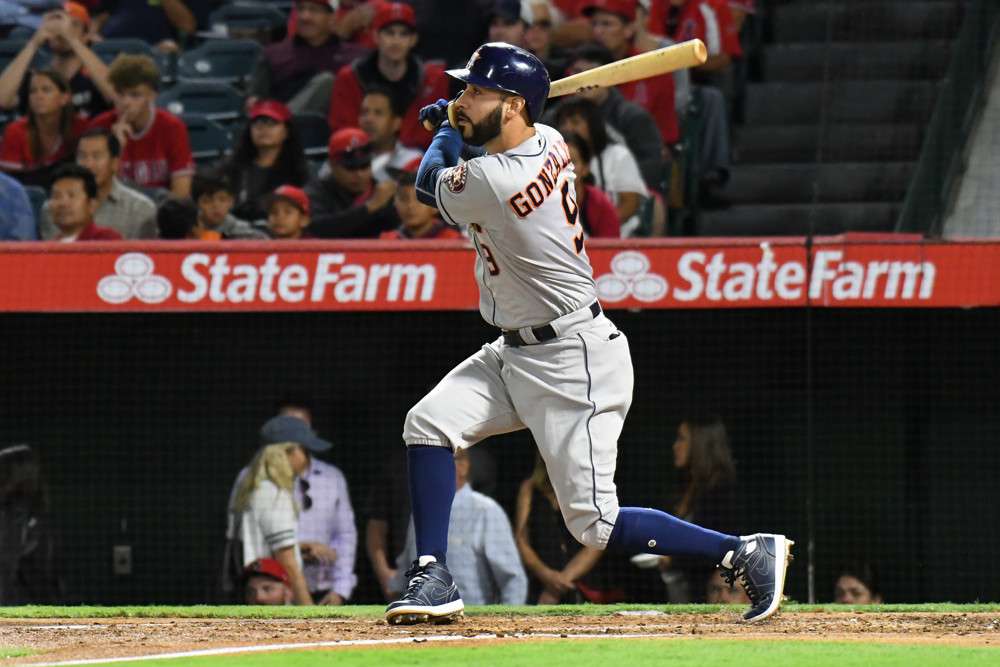
With the 2017 regular season now officially in the rearview mirror, we turn our attention to the 2018 fantasy baseball season. Each week, I will be evaluating one player’s stock for next year. This week, it’s a breakout player who was a key contributor on one of the league’s four remaining teams.
Marwin Gonzalez, Houston Astros
2017 statistics: .303/.377/.530, 23 home runs, 8 stolen bases
Marwin Gonzalez was largely an afterthought in most fantasy leagues entering the season. A potential bench option given his multi-positional versatility, but a career part-time player coming off of a 2016 season with a subpar .254/.293/.401 line. In that context, Gonzalez’s All-Star level age-28 season was one of the bigger surprises this year and he will likely be a popular early-to-mid-round target in drafts next year. Whether Gonzalez can come close to repeating this production next season, though, is an open question.
A detailed look at Gonzalez’s profile reveals only a few subtle underlying changes this season. The most notable adjustment that he made was to become more patient, as he cut his swing rate by six percentage points from last season, taking more pitches both inside and outside of the strike zone. Accordingly, his walk rate this season was nearly double his career average. Impressively, this increase in walks did not come at the expense of an increase in strikeouts, as his strikeout rate remained right in line with his career average at a solid 19.2% clip.
Whether a product of an organizational and personal goal for the player to see more pitches or simply a reflection of the fact that pitchers were more reluctant to pitch Gonzalez in the strike zone than ever before, Gonzalez strikeout-walk profile improved significantly this year. While undoubtedly a positive indicator, this improvement alone would not account for his career-high .303 batting average and 23 home runs in only 515 plate appearances. These figures would require either a corresponding improvement in batted-ball quality or better fortune. While a combination of both, it appears that Gonzalez’s improved results are more a reflection of the latter than the former.
Gonzalez’s batted-ball data in 2017 was essentially unchanged from past years, with the exception of a decrease in his pull-contact rate. He utilized the entire field a bit more this season, which could theoretically explain a .032 percentage point increase in BABIP by making him less susceptible to the shift. However, instead of pulling the majority of his grounders this year, he more frequently began shooting line drives to the opposite field in a manner that he had never done before, which is likely an unsustainable improvement.
Gonzalez did also increase his fly-ball rate slightly this season. Although that came with a corresponding spike in his pop-up rate, so his improved offensive numbers don’t appear to be a reflection of any swing path change or concerted effort to lift the ball. Instead, a HR/FB rate spike of over six percentage points is the most obvious explanation for his power improvement. Although, that has come without any corresponding boost in hard contact rate and only a marginal improvement in his average exit velocity.
While the leaguewide home-run rate has increased slightly over the past few years, players like Gonzalez have been disproportionately benefitted by the home-run spike. That large of a spike without much of a process change involves some measure of good fortune and the 15.8% HR/FB rate that Gonzalez sported excluding a huge month of April is likely a more accurate reflection of his baseline moving forward.
With good health that allows him to accrue an additional 100 plate appearances or so next season, Gonzalez could potentially offset any home-run rate regression to match this year’s total of 23 homers. However, it would require significant projection to envision him being a legitimate 30-home run type. To that end, Gonzalez’s .320 expected weighted on-base average in 2017 (which measures a player’s walks, strikeouts, and contact quality to estimate his offensive performance), while a substantial improvement over last season’s .285 mark, is well off Gonzalez’s actual .381 weighted on-base average. That indicates that he was the beneficiary of quite a bit of good fortune.
While there are reasons to believe that Gonzalez is not as good as the numbers that he put up this season, there are also a multitude of factors working in his favor. Most notably, he hits in the middle of the league’s strongest lineup and in a hitter-friendly home park, making his career-high in runs scored and RBI unsurprising. He is also a switch-hitter, meaning he should continue to play nearly regularly, and, even in a breakout season, Gonzalez was bounced around the diamond yet again and should retain the defensive versatility that was his calling card entering the year.
With a strikeout rate below the league-average and a history of running above-average BABIPs, albeit not at the .343 clip that he did this season, he projects as a .275-.280 hitter who should threaten 20 home runs with a full season’s worth of playing time, more than serviceable when considering the team and park factors working in his favor. However, if Gonzalez is viewed as a hot commodity near the early rounds of drafts next season, owners should likely be wary, as he is primed for some regression in both his batting average and his rate-based power output.
To his credit, Gonzalez did make some small but legitimate improvements in his plate discipline and ability to use the whole field. He has earned the opportunity to continue to start every day in Houston where he should have ample opportunities to hit with runners in scoring position, so there is no doubt that he will be more highly-regarded next March than he was before this season.
